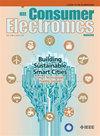A Web 3.0 Integrated Blockchain Enabled Access System Augmented by Meta-Heuristic Cognitive Learning Framework for Mitigating Threats in IoT Enabled Consumer Electronic Devices
IF 4.3
2区 计算机科学
Q1 ENGINEERING, ELECTRICAL & ELECTRONIC
引用次数: 0
Abstract
Consumer Electronic Devices have become an open network model because of the infusion of the Internet of Things (IoT) and other communication technologies such as 5G/6G. Though these devices have provided the high-end sophistication even to common person, but it has proved its darker side by triggering more security breaches and privacy problems. Hence, securing and authenticating these Internet enabled consumer devices has become a probable issue to be solved for safer and secured communication. Therefore, this paper presents a novel fusion of Web 3.0- based Blockchain (WBC) and Deep learning (DL) technique for securing consumer electronic devices in an IoT ecosystem. The proposed framework k(MTD-BCAM) is devised into two components: Multiple-Threat Detection(MTD) and Access Management Mechanism(AMM). In the first component, a DL model is applied for threat detection, whereas WBC is meant for an efficient authentication process. Furthermore, a novel residual fast-gated recurrent neural network is proposed. To reduce the complexity, the komodo Mlipir optimization (KMO) approach is used to tune the hyper-parameters of the network. The comprehensive experimental outcome study of the proposed approach employs NSL-KDD datasets in which the distinct metrics of both DL and Blockchain (BC) are measured and analyzed. Results demonstrated the superior accuracy of the model by achieving 99.78% with less computational time and higher transaction speed. Additionally, the statistical validation and security strength of the model are also analyzed and examined with the varied state-of-art models.一种基于元启发式认知学习框架的Web 3.0集成区块链访问系统,用于减轻物联网消费电子设备中的威胁
由于物联网(IoT)和5G/6G等其他通信技术的注入,消费电子设备已经成为一个开放的网络模式。虽然这些设备为普通人提供了高端的复杂性,但它也证明了它的阴暗面,引发了更多的安全漏洞和隐私问题。因此,保护和验证这些支持Internet的消费者设备已成为一个可能需要解决的问题,以实现更安全的通信。因此,本文提出了一种基于Web 3.0的区块链(WBC)和深度学习(DL)技术的新融合,用于保护物联网生态系统中的消费电子设备。提出的框架k(MTD- bcam)分为两个部分:多威胁检测(MTD)和访问管理机制(AMM)。在第一个组件中,DL模型用于威胁检测,而WBC用于有效的身份验证过程。在此基础上,提出了一种新的残差快速门控递归神经网络。为了降低复杂度,采用komodo Mlipir优化(KMO)方法对网络超参数进行调优。该方法的综合实验结果研究采用NSL-KDD数据集,其中测量和分析了DL和区块链(BC)的不同指标。结果表明,该模型的准确率达到99.78%,计算时间更少,交易速度更快。此外,还分析了模型的统计验证和安全强度,并使用各种最先进的模型进行了检查。
本文章由计算机程序翻译,如有差异,请以英文原文为准。
求助全文
约1分钟内获得全文
求助全文
来源期刊
CiteScore
7.70
自引率
9.30%
发文量
59
审稿时长
3.3 months
期刊介绍:
The main focus for the IEEE Transactions on Consumer Electronics is the engineering and research aspects of the theory, design, construction, manufacture or end use of mass market electronics, systems, software and services for consumers.

 求助内容:
求助内容: 应助结果提醒方式:
应助结果提醒方式:


